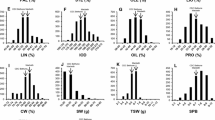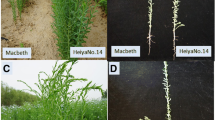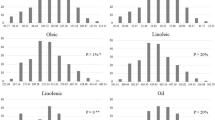Abstract
Linseed (Linum usitatissimum L.) is an important oilseed as well as stem fiber crop and rich source of omega-3 fatty acid. The present study aims to develop linkage map based on Indian genotypes and utilize it for mapping QTLs for important agronomic traits. Two diverse parental genotypes (KL-213 and RKY-14) of linseed showed wide range of variability for oil content and yield attributes. These parental genotypes also showed reasonable level of SSR polymorphism (~ 9.0%). The mapping population showed normal distribution of phenotypic traits. One hundred forty-six SSR markers were mapped on 15 linkage groups with marker density ranging from 3 to 18 markers per linkage group at average distance of 14.2 cM. A total of 11 QTLs were identified for six quantitative traits. Three QTLs for capsules/plant, 2 QTLs each for plant height, seeds/capsule and oil content and 1 QTL each for branches/plant and seed weight/plant were detected. Phenotypic variability explained by these QTLs varied from 1 to 15.23%. This study provides framework linkage map of linseed using Indian genotypes, which needs to be enriched further for future application in marker assisted breeding of linseed.


Similar content being viewed by others
References
Adugna W, Labuschagne MT, Viljoen CD (2006) The use of morphological and AFLP markers in diversity analysis of linseed. Biodivers Conserv 15:3193–3205
Chandrawati, Maurya R, Singh PK, Ranade SA, Yadav HK (2014) Diversity analysis in Indian genotypes of linseed (Linum usitatissimum L.) using AFLP marker. Gene 549:171–178
Chandrawati, Singh N, Kumar R, Kumar S, Singh PK, Yadav VK, Ranade SA, Yadav HK (2017) Genetic diversity, population structure and association analysis in linseed (Linum usitatissimum L.). Physiol Mol Biol Plants 23:207–219
Cloutier S, Niu Z, Datla R, Duguid S (2009) Development and analysis of EST-SSRs for flax (Linum usitatissimum L.). Theor Appl Genet 119:53–63
Cloutier S, Ragupathy R, Zhixia N, Duguid S (2011) SSR-based linkage map of flax (Linum usitatissimum L.) and mapping of QTLs underlying fatty acid composition traits. Mol Breed 28:437–451
Cloutier S, Miranda E, Ward K, Radovanovic N, Reimer E, Walichnowski A, Datla R, Rowland G, Duguid S, Ragupathy R (2012a) Simple sequence repeat marker development from bacterial artificial chromosome end sequences and expressed sequence tags of flax (Linum usitatissimum L.). Theor Appl Genet 125:685–694
Cloutier S, Ragupathy R, Miranda E, Radovanovic N, Reimer E, Walichnowski A, Ward K, Rowland G, Duguid S, Banik M (2012b) Integrated consensus genetic and physical maps of flax (Linum usitatissimum L.). Theor Appl Genet 125:1783–1795
Cullis CA (2007) Flax. In: Kole C (ed) Genome mapping and molecular breeding in plants, vol 2. Springer, Berlin, pp 275–295
Dash M, Samal KC (2016) Agro-molecular diversity analysis of linseed (Linum usitatissimum L) genotypes using microsatellite based simple sequence repeats (SSR) marker. J Plant Sci Res 32:87
de Campos T, Oblessuc PR, Sforça DA, Cardoso JM, Baroni RM, de Sousa AC, Carbonell SA, Chioratto AF, Garcia AA, Rubiano LB, de Souza AP (2011) Inheritance of growth habit detected by genetic linkage analysis using microsatellites in the common bean (Phaseolus vulgaris L.). Mol Breed 27:549–560
Deng X, Long SH, He DF, Li X, Wang YF, Liu J, Chen XB (2010) Development and characterization of polymorphic microsatellite markers in Linum usitatissmum. J Plant Res 123:119–123
Deng X, Long SH, He DF, Li X, Wang YF, Hao DM, Qiu CS, Chen XB (2011) Isolation and characterization of polymorphic microsatellite markers from flax (Linum usitatissimum L.). Afr J Biotechnol 10:734–739
Doligez A, Adam-Blondon AF, Cipriani G, Di Gaspero G, Laucou V, Merdinoglu D, Meredith CP, Riaz S, Roux C, This P (2006) An integrated SSR map of grapevine based on five mapping populations. Theor Appl Genet 113:369–382
Everaert I, de Riek J, de Loose M, van Waes J, van Bockstaele E (2001) Most similar variety grouping for distinctness evaluation of flax and linseed (Linum usitatissimum L.) varieties by means of AFLP and morphological data. Plant Var Seeds 14:69–87
FAOSTAT (2014) Food and Agriculture Organization. http://faostat3.fao.org/home/index.html
Fu YB (2006) Redundancy and distinctness in flax germplasm as revealed by RAPD dissimilarity. Plant Genet Resour 4:117–124
Fu YB, Diederichsen A, Richards KW, Peterson G (2002a) Genetic diversity within a range of cultivars and landraces of flax (Linum usitatissimum L.) as revealed by RAPDs. Genetic Res Crop Evol 49:167–174
Fu YB, Peterson G, Diederichsen A, Richards KW (2002b) RAPD analysis of genetic relationships of seven flax species in the genus Linum L. Genet Res Crop Evol 49:253–259
Gill KS (1987) Linseed publications and information division. Indian Council of Agricultural Research, New Delhi
Hackett CA, Broadfoot LB (2003) Effect of genotyping errors, missing values and segregation distortion in molecular marker data on the construction of linkage maps. Heredity 90:33–38
Hong Y, Chen X, Liang X, Liu H, Zhou G, Li S, Wen S, Holbrook CC, Guo B (2010) A SSR-based composite genetic linkage map for the cultivated peanut (Arachis hypogaea L.) genome. BMC Plant Biol 10:17
Kosambi DD (1994) The estimation of map distances from recombination values. Ann Eugen 12:172–175
Kumar S, You FM, Duguid S, Booker H, Rowland G, Cloutier S (2015) QTL for fatty acid composition and yield in linseed (Linum usitatissimum L.). Theor Appl Genet 128:965–984
Lander ES, Green P, Abrahamson J, Barlow A, Daly MJ, Lincoln SE, Newburg L (1987) MAPMAKER: an interactive computer package for constructing primary genetic linkage maps of experimental and natural populations. Genomics 1:174–181
Lu H, Romero-Severson J, Bernardo R (2002) Chromosomal regions associated with segregation distortion in maize. Theor Appl Genet 105:622–628
Oh TJ, Gorman M, Cullis CA (2000) RFLP and RAPD mapping in flax (Linum usitatissimum). Theor Appl Genet 101:590–593
Pali V, Verma SK, Xalxo MS, Saxena RR, Mehta N, Verulkar SB (2014) Identification of microsatellite markers for fingerprinting popular Indian flax (Linum usitatissimum L.) cultivars and their utilization in seed genetic purity assessments. Aust J Crop Sci 8:119
Pali V, Mehta N, Verulkar SB, Xalxo MS, Saxena RR (2015) Molecular diversity in Flax (Linum usitatissimum L.) as revealed by DNA based markers. Int J Plant Res 28:157–165
Roose-Amsaleg C, Cariou-Pham E, Vautrin D, Tavernier R, Solignac M (2006) Polymorphic microsatellite loci in Linum usitatissimum. Mol Ecol Notes 6:796–799
Saghai-Maroof MA, Soliman KM, Jorgensen RA, Allard RW (1984) Ribosomal DNAsepacer-length polymorphism in barley: mendelian inheritance, chromosomal location, and population dynamics. Proc Natl Acad Sci (USA) 81:1757–1761
Schuelke M (2000) An economic method for the fluorescent labeling of PCR fragments. Nat Biotechnol 18:233–234
Song KM, Suzuki JY, Slocum MK, Williams PM, Osborn TC (1991) A linkage map of Brassica rapa (syn. campestris) based on restriction fragment length polymorphism loci. Theor Appl Genet 82:296–304
Soto-Cerda BJ, Carrasco RA, Aravena GA, Urbina HA, Navarro CS (2011a) Identifying novel polymorphic microsatellites from cultivated flax (Linum usitatissimum L.) following data mining. Plant Mol Biol Rep 29:753–759
Soto-Cerda BJ, Saavedra HU, Navarro CN, Ortega PM (2011b) Characterization of novel genic SSR markers in Linum usitatissimum (L.) and their transferability across eleven Linum species. Electron J Biotechnol 14:4
Soto-Cerda BJ, Duguid S, Booker H, Rowland G, Diederichsen A, Cloutier S (2014) Association mapping of seed quality traits using the Canadian flax (Linum usitatissimum L.) core collection. Theor Appl Genet 127:881–896
Spielmeyer W, Green AG, Bittisnich D, Mendham N, Lagudah ES (1998) Identification of quantitative trait loci contributing to Fusarium wilt resistance on an AFLP linkage map of flax. Theor Appl Genet 97:633–641
Thoquet P, Gherardi M, Journet EP, Kereszt A, Ane JM, Prosperi JM, Huguet T (2002) The molecular genetic linkage map of the model legume Medicago truncatula: an essential tool for comparative legume genomics and the isolation of agronomically important genes. BMC Plant Biol 2:1
Uysal H, Fu Y-B, Kurt O, Peterson GW, Diederichsen A, Kusters P (2010) Genetic diversity of cultivated flax (Linum usitatissimum L.) and its wild progenitor pale flax (Linum bienne Mill.) as revealed by ISSR markers. Genet Resour Crop Evol 57:1109–1119
Voorrips RE (2006) MapChart 2.2: software for the graphical presentation of linkage maps and QTLs. Plant Research International, Wageningen
Wang S, Batsen CJ, Zeng ZB (2007) Windows QTL cartographer 2.5. Department of Statistics, North Carolina State University, Raleigh
Westcott ND, Muir ND (2003) Chemical studies on the constituents of Linum sp. In: Muir AD, Westcott ND (eds) Flax, the genus Linum. Taylor and Francis, New York, pp 55–73
Acknowledgements
Authors thank the Director, CSIR-NBRI, Lucknow for providing the facilities to carry out the present investigation. Financial support in form of DST-INSPIRE Fellowship to Chandrawati is gratefully acknowledged.
Author information
Authors and Affiliations
Corresponding author
Electronic supplementary material
Below is the link to the electronic supplementary material.
Rights and permissions
About this article
Cite this article
Chandrawati, Yadav, H.K. Development of linkage map and mapping of QTLs for oil content and yield attributes in linseed (Linum usitatissimum L.). Euphytica 213, 258 (2017). https://doi.org/10.1007/s10681-017-2050-x
Received:
Accepted:
Published:
DOI: https://doi.org/10.1007/s10681-017-2050-x




